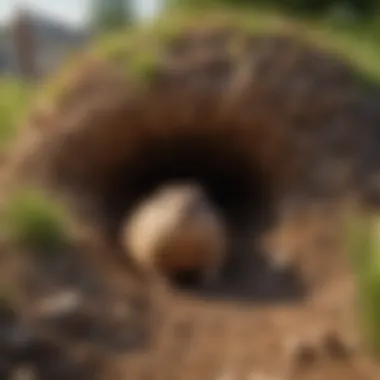Understanding Talpirid for Effective Gopher Control


Intro
Gophers can pose significant challenges for homeowners and gardeners alike. These small rodents are known for their burrowing habits, which can undermine landscaping and agricultural endeavors. Understanding how to manage gopher populations is essential for maintaining a healthy and thriving garden. One effective solution worth exploring is Talpirid. This article will delve into the specifics of Talpirid, including its composition, effectiveness, and application strategies, while also considering its ecological implications and comparing it with other control options. Through this comprehensive guide, homeowners will be better equipped to make informed pest management decisions to combat gopher issues successfully.
Pest Identification
Gophers belong to the family Geomyidae. Typically, the most common gopher species encountered by homeowners are thePocket gopher and the Botta’s gopher.
Detailed Descriptions of Common Pests
- Pocket Gopher: Characterized by its stout body and fur-lined cheek pouches. These rodents typically measure around 6 to 8 inches in length. Their fur is soft and usually light brown or gray, enabling them to blend into soil environments.
- Botta's Gopher: Slightly larger, reaching up to a foot long. This species is easily recognizable by its distinct coloration which includes grayish-brown fur. It also features small, hairy ears that are less pronounced than those of other rodent varieties.
Signs and Symptoms of Infestations
An infestation of gophers can be identified through several noticeable signs:
- Mounds of Soil: Gophers push soil to the surface, creating mounds that can be two to three feet wide. The presence of mounds indicates gopher activity.
- Damaged Plants: If the roots of plants appear gnawed or the plants themselves show signs of wilting despite adequate watering, this may suggest gopher feeding.
- Increased Burrow Openings: Multiple entry points in the soil can be evident, indicating an established presence.
Recognizing these signs early can help mitigate the damage before it escalates.
Prevention Strategies
Implementing effective prevention strategies may lessen the possibility of gopher infestations in gardens and yards.
Home Maintenance Tips for Pest Prevention
- Keep your garden well-mulched, which can deter gophers from burrowing.
- Regularly check for fresh soil mounds and act quickly if spotted.
- Maintain healthy plants, as weak plants are more attractive to pests.
- Consider using fencing that extends below the ground surface to prevent gophers from entering.
Natural Deterrents and Barriers
Some natural methods can effectively deter gophers:
- Castor Oil: This is known to repel gophers when mixed with water and applied to infested soil.
- Planting Deer-Resistant Varieties: Certain plants are less appealing to gophers and may help deter them.
- Physical Barriers: Placing wire mesh around young plants can protect their roots from gopher damage.
Treatment Options
When preventive measures fall short, treatment options become pivotal in managing gopher populations.
Overview of Chemical vs. Natural Treatments
- Chemical Treatments: Talpirid stands out as a well-known commercial bait used to control gophers. Its key ingredient is bromethalin, a potent neurotoxin designed to kill gophers after ingesting the bait.
- Natural Treatments: Options such as traps can provide a non-chemical method for gopher control. Snap traps designed specifically for gophers can be strategically placed near active burrows.
Step-by-Step Guides for DIY Treatments
To use Talpirid effectively, follow these steps:
- Identify Active Burrows: Locate areas with fresh soil mounds.
- Prepare Bait: Wear gloves when handling Talpirid to avoid contamination.
- Insert Bait: Place the bait deep into the burrow using a funnel, ensuring it is out of reach of non-target animals.
- Seal The Burrow: Cover the burrow with soil after placing the bait to minimize disturbance.
- Monitor: Check the area after a few days to assess the effectiveness, and replenish bait if necessary.
Prologue to Talpirid
Talpirid is a recognized product designed specifically for the control of gopher populations. The need for effective gopher management arises from the problems these creatures can create in gardens, lawns, and agricultural areas. Gophers are known for their burrowing habits, which can disrupt plant roots, damage landscaping, and even compromise the integrity of structures.
Understanding Talpirid involves appreciating both its formulation and functionality. This product contains specific active ingredients that are designed to target gophers, making it a preferred choice for homeowners and pest management professionals. The relevance of this section lies in the benefits Talpirid offers, including its efficiency and specificity. Knowing how Talpirid works helps users make informed decisions, potentially saving time and resources in pest control efforts.
Moreover, the consideration of safety and environmental impact is crucial when discussing any pest control method. Talpirid, when used correctly, aims to minimize these concerns. In this article, we will explore various facets of Talpirid, ranging from its composition to practical application methods. By the end of this discussion, homeowners will have a clearer perspective on how to manage gopher-related issues using Talpirid effectively.
Composition of Talpirid
Understanding the composition of Talpirid is crucial for anyone considering its use for gopher control. The effectiveness of this product can be directly linked to the specific ingredients it contains. Knowing what these ingredients are helps users appreciate how Talpirid works and its overall safety in various environments.
Active Ingredients
The active ingredients in Talpirid are central to its function. Talpirid utilizes bromethalin, a potent neurotoxin that effectively targets gophers. This ingredient disrupts the cognitive functions of these pests. It is important to note that bromethalin acts quickly, causing paralysis and eventually leading to death.
This rapid action is one of the main advantages of Talpirid. It minimizes disruption to the landscape since gophers are removed before they can cause extensive damage to lawns and gardens. Additionally, the effectiveness of bromethalin helps reduce the need for multiple applications, making it a cost-effective choice for homeowners.
Inactive Ingredients
While the active ingredients are essential, the inactive ingredients in Talpirid also play a significant role. These ingredients often serve as carriers or stabilizers, ensuring that the active compound remains effective over time. Common inactive components include various emulsifiers and fillers, which enhance the product's application and effectiveness.
Understanding the inactive ingredients is vital for assessing the product's safety. They are generally designed to assist and do not contribute to toxicity in the same way that the active ingredients do. However, their presence can affect how the product interacts with the environment. When using any pest control solution, one must be consider carefully not only the intended targets but also the broader ecological impact.


Mechanism of Action
Understanding the mechanism of action for Talpirid is essential. It offers insights into how this product effectively manages gopher populations. This section will highlight critical details related to how Talpirid interacts with gophers and the resultant benefits. Knowing the science behind its operation can assist homeowners in making informed decisions about pest control methods.
How Talpirid Affects Gophers
Talpirid works primarily by targeting the nervous system of gophers. When gophers ingest the bait, the active ingredient disrupts their normal neural processes. This disruption leads to a swift immobilization, which ultimately results in death. The design of Talpirid ensures that gophers are attracted to the bait, making it effective in both residential and agricultural settings.
The appeal lies in the specific formulation of the bait, which is crafted to mimic natural food sources for gophers. This increases the likelihood of consumption. Moreover, Talpirid is designed to be highly palatable, ensuring that even cautious gophers are drawn to it.
The quick action on gophers reduces their population effectively, and this immediate impact can be observed in various environments. Homeowners report a marked decrease in the presence of gophers shortly after application, illustrating the effectiveness of this product in real-world settings.
Speed of Efficacy
The speed at which Talpirid operates plays a significant role in its appeal. Once consumed, gophers typically exhibit signs of distress within hours. The visible effects manifest quickly, often eliminating the problem within a short timeframe compared to other control methods.
Research indicates that many users see substantial results within 24 to 48 hours after deployment. Such rapid outcomes are particularly valuable for those facing immediate challenges with pest populations. The expedited control also lessens the chances of damage to gardens and lawns, a common worry among homeowners.
"Timeliness is crucial in gopher control. The faster a solution works, the less damage a population can cause."
Furthermore, the speed of Talpirid's action minimizes the need for repeated applications. This efficiency translates to reduced labor and financial outlay for homeowners, making it a sensible choice in pest management.
In summary, understanding the mechanism of action allows homeowners to appreciate how Talpirid functions at a biological level and the advantages it brings in addressing gopher issues quickly and effectively.
Application Methods
Understanding the application methods of Talpirid is crucial for ensuring effective gopher control. This section addresses recommended techniques and safety precautions involved in applying this product. Proper application not only maximizes its effectiveness but also minimizes risks to non-target species and the environment.
Recommended Techniques
When using Talpirid, adherence to recommended techniques enhances the likelihood of success. Here are some key methods to consider:
- Site Assessment: Before application, it is important to identify active gopher tunnels. This ensures that Talpirid targets areas where gophers are most likely to be present.
- Bait Placement: Talpirid is designed as a bait. Place it directly into the gopher tunnels. Using tools like a probe or a baiting applicator can help ensure accurate placement.
- Gopher Mounds: When applying, look for fresh gopher mounds. Insert the bait into the tunnels near these mounds for better exposure to the target pests.
- Timing: The best time to apply Talpirid is during the active seasons for gophers. Typically, spring and fall are ideal times. Weather conditions, such as moisture levels, can also affect bait uptake.
Following these techniques contributes to more effective application and management of gopher populations.
Safety Precautions
Applying any pest control product requires careful consideration of safety precautions. These help protect both users and the environment. Here are some essential safety guidelines to keep in mind:
- Follow Label Instructions: Always read and adhere to the product's label. This provides information on how much to apply, application intervals, and other critical safety data.
- Personal Protective Equipment (PPE): When handling Talpirid, wear appropriate PPE. This may include gloves, masks, and eye protection.
- Keep Away from Pets and Children: Ensure that the application sites are inaccessible to pets and young children until the bait is fully integrated into the ground. This precaution mitigates any accidental ingestion.
- Proper Disposal: After application, dispose of any unused bait and packaging according to local regulations. This prevents unintentional harm to wildlife.
- Environmental Monitoring: Observe the area for signs of non-target species interactions. It is important to be vigilant and take necessary measures if unexpected wildlife is affected.
By being aware of these techniques and implementing safety precautions, individuals can manage gopher populations effectively while minimizing risks.
Adopting these recommended techniques and safety measures will create a comprehensive strategy for using Talpirid. This structured approach not only addresses specific gopher control needs but ensures responsible stewardship of the environment.
Advantages of Using Talpirid
Understanding the advantages of Talpirid is critical for homeowners dealing with gopher infestations. Talpirid offers a specialized solution tailored to effectively control gopher populations while minimizing unintended consequences. The focus should be on its unique benefits and how it integrates into broader pest management strategies.
Targeted Action
One of the primary advantages of Talpirid is its targeted action against gophers. This means that when Talpirid is deployed, it specifically affects the gopher population while having minimal influence on other small mammals. The active ingredients in Talpirid work efficiently to eliminate gophers within their burrows. This targeted approach allows homeowners to manage pest populations without unnecessarily impacting beneficial wildlife.
This precision reduces the risk of lethal effects on species that can benefit the local ecosystem, such as other non-target animals. The focused nature of Talpirid is essential for those who wish to keep their gardens and backyards thriving without harming the surrounding environment.
"Targeted applications can preserve ecological balance while managing pest populations effectively."
Reduced Impact on Non-Target Species
Another significant benefit of using Talpirid is its reduced impact on non-target species. In pest control, one major concern is the potential harm to animals that are not the intended targets of treatment. Talpirid has been designed with this consideration in mind. The formulation is selective enough to minimize interactions with non-target wildlife, providing peace of mind for homeowners.
This advantage is especially pertinent in areas where various wildlife coexist. For instance, pets, birds, and other small creatures are less likely to be adversely affected when Talpirid is applied correctly. In addition, this quality adds an ethical dimension to pest control management, aligning with the values of environmentally conscious homeowners.
In summary, the advantages of using Talpirid extend beyond efficient gopher elimination. Its targeted action and minimal impact on non-target species make it a compelling choice for anyone aiming for effective pest control while prioritizing environmental considerations.
Comparison with Other Gopher Control Methods
In the realm of pest management, understanding various methods for gopher control is crucial. Evaluating Talpirid against other options helps determine its suitability for different environments. This comparison highlights specific elements, benefits, and considerations essential for homeowners and pest control professionals.
Mechanical Traps


Mechanical traps are a popular alternative to chemical solutions like Talpirid. These traps operate by physically capturing gophers when they enter. Some common types include scissor traps and harpoon traps. Mechanical traps have a few advantages:
- Immediate results: When set up correctly, these traps can provide quick eradication of gopher populations.
- No chemical exposure: For those wary of chemicals, traps offer a pesticide-free solution.
However, there are notable downsides:
- Labor-intensive: Setting and checking traps require significant effort and time.
- Non-target species: There is a risk of capturing other small animals unintentionally, leading to ecological concerns.
For homeowners, family safety and ease of use play critical roles in decision making. Thus, while mechanical traps are effective, they may not be suitable for every situation.
Natural Deterrents
Another category in gopher control is natural deterrents. These options often include homemade solutions, such as castor oil or planting certain plants that gophers dislike. Natural deterrents come with their merits:
- Eco-friendly: They are less likely to harm other wildlife and the environment.
- Simplicity: Application often involves straightforward methods, making them accessible for most homeowners.
On the flip side, natural deterrents may not always yield immediate results or complete control. They often require consistent application and observation to see any meaningful effects on gopher populations.
Environmental Impact
The environmental impact of Talpirid is a crucial consideration in pest management strategies for gopher control. Homeowners and pest control professionals are increasingly aware of these effects, as the implications of using chemical solutions extend beyond the target pests. It is vital to evaluate how such products interact with local ecosystems, including impacts on non-target species and the overall health of the environment.
When assessing the use of Talpirid, it is important to examine several specific elements:
- Target Specificity: Talpirid is engineered to specifically target gophers. This characteristic minimizes its impact on other wildlife, making it a more ecologically responsible choice when compared to more indiscriminate pest control methods that could harm beneficial organisms.
- Decomposition and Residue: The breakdown of Talpirid's active ingredients poses potential risks. A product’s longevity in the environment can influence soil health and water sources, which is critical for both agriculture and local ecosystems. Understanding the degradation of ingredients helps in assessing the long-lasting impacts on the environment.
- Behavioral Responses: It is also essential to consider how the use of Talpirid might affect the behaviors of other species. For instance, the presence of dead gophers may attract scavengers, which while a natural process, can lead to unintended consequences for these animals, especially if they are exposed to the remnants of the Talpirid formula.
The benefits of managing gopher populations effectively without causing undue harm to the environment cannot be overstated. Successful pest management strategies require a balance between effectiveness and ecological responsibility.
"Understanding the environmental impact of any pest control method is not just good practice; it is essential for sustainable pest management."
Ecological Considerations
Ecological considerations are paramount when introducing Talpirid into any environment. Evaluating the local ecosystem can help predict the efficacy and risks of introducing this product. Factors to consider include:
- Biodiversity: Implementing Talpirid should account for the biodiversity of the area. Environments with varied wildlife might experience different reactions to its application.
- Soil Health: The effects on soil organisms need greater scrutiny. Healthy soil contributes significantly to crop yields and local flora. The ingredients of Talpirid should not compromise these vital organisms.
- Waterway Protection: Preventing runoff into nearby water bodies is critical. Contamination from pest control products can lead to additional ecological issues, such as affecting aquatic life. Awareness around application timing and methods can help mitigate these risks.
Regulatory Guidelines
Regulatory guidelines for the use of Talpirid are designed to ensure its application is safe for both users and the environment. These rules dictate how and where Talpirid can be utilized, which is important for several reasons:
- Compliance: It is crucial for homeowners and professionals to comply with local pesticide regulations, which are established to protect public health and ecological integrity.
- Safe Usage: Guidelines ensure that Talpirid's application does not pose risks to humans or pets in the surrounding area. Adherence to safety protocols can minimize potential exposure and health risks.
- Documentation and Reporting: Following regulatory guidelines often involves thorough documentation that aids in tracking effectiveness and environmental impact. This transparent process can facilitate better pest management practices in the future.
In summary, the discussion around environmental impact pertaining to Talpirid focuses on the balance between effective gopher control and maintaining ecological health. Addressing these points ensures a comprehensive understanding and responsible use of this pest control solution.
Case Studies and Field Reports
Case studies and field reports are vital components in understanding the real-world application and effectiveness of Talpirid as a gopher control solution. They provide observational evidence and practical insights that can validate the claims made by manufacturers about the product's efficiency. By examining specific instances of Talpirid's usage, readers can assess how it performs under various conditions. These reports not only showcase success stories but also highlight any challenges that may arise during application.
Furthermore, case studies offer a comparative perspective against other methods available for gopher management. They present detailed accounts of different settings—rural versus urban, gardens versus larger landscapes—enhancing comprehension of where Talpirid is most effective. In doing so, they inform homeowners on what may be possible in their unique situations.
"Insights gained from real-world applications of Talpirid significantly inform our approach to gopher management."
Successful Application in Residential Areas
The successful application of Talpirid in residential areas shows its potential as a reliable solution for gopher problems commonly faced by homeowners. Reports reveal that when used correctly, Talpirid allows for targeted gopher elimination without causing undue impact on the surrounding environment.
Homeowners have reported significant reductions in gopher activity in their yards, which leads to healthier lawns and gardens. For instance, in a community in California, residents who utilized Talpirid noted visible results within just a few days. This swift action is particularly beneficial as it mitigates further damage to properties and landscaping.
When implementing Talpirid, it is essential to follow application guidelines, such as ensuring burrows are properly baited. Additionally, utilizing it during peak gopher activity periods enhances effectiveness. These considerations contribute to more favorable outcomes in residential applications.
Challenges in Diverse Environments
Despite its advantages, Talpirid can encounter challenges in diverse environmental settings. Variations in soil types, vegetation, and local wildlife behavior can influence how effectively the product works. For instance, in sandy soils, gophers may create multiple burrow systems, complicating the distribution of the bait.
Field reports indicate that in regions with higher populations of non-target species, there can be concerns about those species consuming the bait. This necessitates careful application strategies to minimize risks. Some homeowners expressed difficulties in ensuring the bait reaches gopher burrows effectively without being disturbed by other animals.
Moreover, factors such as weather conditions can impact Talpirid's performance. Heavy rains may wash away the bait or cause it to become less palatable to gophers. Consequently, understanding these challenges can lead to the refinement of application practices and guide users on when and how to apply Talpirid for optimal results.
Consumer Reviews and Feedback
Understanding consumer reviews and feedback is crucial in evaluating Talpirid as an effective gopher control solution. These opinions provide insights from actual users who have experience with the product. Analyzing this feedback allows potential customers to gauge how well Talpirid performs in various settings and to learn about any common issues that others faced. Positive reviews can enhance the credibility of Talpirid, while negative ones can serve as a warning.


Evaluating feedback also informs users about the contexts in which Talpirid has proven effective and any limitations users might encounter. For homeowners, practical insights from fellow users can be invaluable in deciding whether to invest in this particular pest control method.
Additionally, exploring feedback can also lead to better product understanding, ensuring that users are not only aware of the product's strengths but also understand how to apply it effectively.
Satisfaction Rates
Satisfaction rates are a significant metric when assessing Talpirid's effectiveness. Users frequently report their success rates with the product, highlighting positives such as effective elimination of gopher infestations. Many homeowners mention that they have seen notable results within a short time frame after application.
For example, some reviews emphasize that gophers noticeably decreased within days of using Talpirid, affirming its fast-acting nature. Being aware of high satisfaction rates can encourage new customers to try the product, believing that it may similarly meet their needs.
Interestingly, satisfaction can vary depending on the environment and the specific gopher population. Therefore, evaluating these ratings helps prospective buyers consider their situations before purchasing Talpirid.
Common Concerns
While Talpirid has many satisfied users, there are common concerns that potential buyers should take note of. These often relate to the ease of application, potential environmental impacts, or cost concerns. Some reviews indicate that the method of applying Talpirid can be complex for beginners or those unfamiliar with pest control products. Clear instructions play a vital role in alleviating some of these issues.
Moreover, another prevalent concern is the possible impact on non-target species. Even though Talpirid is designed for gopher control, users tend to worry about unintended effects on beneficial wildlife. It is essential to balance pest control with ecological responsibility.
Lastly, some consumers raise concerns regarding the price point of Talpirid in comparison to other gopher control methods. Evaluating cost-effectiveness against results is a critical point that arises frequently.
In summary, consumer feedback serves as an essential component in formulating a comprehensive view of Talpirid. It highlights areas of strength, while also shedding light on challenges and concerns, allowing informed decisions regarding its use.
Legal and Ethical Considerations
In the realm of pest control, particularly concerning products such as Talpirid, it is imperative to understand the legal and ethical aspects. The impact of pest control methods extends beyond immediate results and resonates within broader ecological frameworks. This section explores key regulations and the ethical implications surrounding the usage of Talpirid in managing gopher populations, equipping homeowners with information crucial for responsible pest management.
Pesticide Regulations
Compliance with pesticide regulations is non-negotiable when using products like Talpirid. These regulations are in place to ensure the safety of humans, non-target species, and the environment. Regulatory bodies, such as the Environmental Protection Agency (EPA) in the United States, set guidelines that dictate how pesticides can be manufactured, sold, and applied.
- Registration: Before any pesticide can be sold or used, it must undergo a thorough evaluation. This evaluation assesses risks and benefits to ensure the product is safe for designated use.
- Application Guidelines: Proper application methods are defined in regulation documents. Following these guidelines minimizes unintended exposure to non-target organisms and ensures that the product's effectiveness is maximized.
- Label Instructions: The product label not only serves as a legal document but also provides critical information on how to use the pesticide safely and effectively. Homeowners must read and adhere to these instructions to stay in compliance and maintain safety standards.
"Pesticide regulations are not just legal obligations; they are vital for protecting public health and biodiversity."
Familiarizing oneself with local regulations is crucial. Rules can vary by state or municipality, and misjudgment could lead to fines or more serious legal consequences. Understanding these regulations promotes accountability and responsible usage of Talpirid.
Ethical Use in Pest Control
The ethical dimensions of using Talpirid focus on the responsibility that homeowners and pest control professionals must uphold. While controlling gopher populations is often necessary to protect gardens and landscapes, the methods employed should reflect a commitment to ethical treatment of living organisms.
- Targeted Control: Employing Talpirid focuses on the pest species while minimizing harm to other wildlife. This targeted approach reduces collateral damage, preserving local ecosystems.
- Mitigating Suffering: It is important to consider the impact of extermination methods on the target species. Talpirid functions quickly to reduce prolonged suffering in gophers, making it a more humane option compared to other alternatives.
- Public Awareness: As stewards of the environment, homeowners should engage with their communities about pest management practices. Sharing knowledge on the responsible use of Talpirid promotes transparency, fostering an ethical approach to pest control.
In summary, both legal and ethical considerations play vital roles in the responsible use of Talpirid. Respecting regulations and committing to ethical practices ensure that these pest control methods contribute to environmental health rather than detract from it.
Future Trends in Gopher Control
Understanding the future trends in gopher control is crucial for home and property owners looking to effectively manage gopher populations. As we expand our knowledge of pest management, innovations and advancements significantly impact the efficiency of solutions like Talpirid. The necessity for sustainable and environmentally responsible practices is rising, highlighting the value of these trends in aligning pest control methods with ecological health.
Innovations in Pest Management
The field of pest management continues to evolve with the introduction of innovative products and strategies. One notable trend is the development of biorational pesticides. These products offer targeted effects on gophers while having minimized impacts on the surrounding ecosystem. Alongside traditional methods, these alternatives tend to focus on lower toxicity and environmental safety, addressing the concerns increasingly shared by homeowners.
New trapping technologies also offer improvements in efficiency. Modern traps are designed for higher effectiveness with humane considerations. This innovation is essential to ensure that while controlling gopher populations, we do not compromise humane treatment.
Additionally, the integration of information about gopher behavior and biology has informed the design of control strategies. For example, understanding gopher foraging patterns can guide when and where treatments like Talpirid should be applied, increasing efficacy and reducing wasted resources.
Integration of Technology
Emerging technologies play a vital role in the trends surrounding gopher control. The use of GPS and drones for monitoring gopher activity allows for high-precision applications. Property owners can receive real-time data on gopher populations, which helps tailor control strategies more effectively.
Smart pest management systems use sensors and data analysis to assess gopher activity levels. These systems can provide alerts, offering timely insights into when interventions are needed.
With cloud technology, the collected data can be analyzed to predict gopher behavior, allowing for proactive measures rather than reactive responses. Such technologies effectively transform traditional pest control into a data-driven approach, leading to better outcomes and resource allocation.
The integration of technology and innovation in pest management is redefining how homeowners approach gopher control, promoting more effective and responsible methods.
As these trends continue, awareness and education will be essential for homeowners. By staying informed about these advancements, they can make informed decisions that enhance pest management strategies while ensuring ecological balance.
The End
In this article, we have explored the multifaceted nature of Talpirid as a gopher control solution. Understanding Talpirid involves comprehending its unique composition, the way it operates, and the various methods for application. Each aspect plays a crucial role in its effectiveness as a pest management tool.
The primary takeaway is that Talpirid stands out among gopher control methods due to its targeted approach. This specificity not only aids in effectively managing gopher populations but also minimizes the impact on non-target species. Such a balance is vital for those looking to maintain ecological integrity while addressing pest issues in their homes or gardens.
Moreover, we discussed the practical methods of application and emphasized the importance of following safety precautions. Recognizing the potential risks related to pesticide use ensures responsible and effective pest management. Homeowners and professionals alike must understand these elements to make informed decisions about their pest control strategies.
Additionally, insights into consumer feedback emphasize its acceptance in the market. Observing satisfaction rates and addressing common concerns fosters ongoing improvements in products like Talpirid, encouraging a feedback loop that benefits users.
Benefits of References:
- Credibility: Reinforces the reliability of the information.
- Further Learning: Guides readers to additional resources.
- Diverse Perspectives: Offers various viewpoints to deepen understanding.
- Informed Decision Making: Helps consumers make educated choices regarding pest control.



